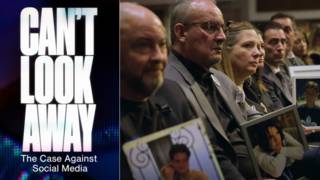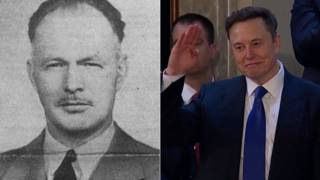
Communities in Milwaukee are continuing to voice outrage over an all-white jury’s decision to acquit three white police officers charged with brutally beating an African-American man. We go to Milwaukee to speak with the victim’s aunt and his attorney about the stunning verdict. [includes rush transcript]
Communities in Milwaukee are continuing to voice outrage over an all-white jury’s decision to acquit three white police officers charged with brutally beating an African-American man. Local religious leaders and activists are planning protests against the stunning verdict, including a march this morning and a fast later this week.
U.S. attorneys are now considering filing federal charges against the officers and Milwaukee’s Chief of Police has launched an internal investigation.
The victim, Frank Jude, was nearly killed in October 2004 when he was beaten at a party by a group of off-duty police officers, all of whom are white.
According to news accounts, they accused Jude of stealing the wallet and badge of one of the officers. As many as 15 officers surrounded Jude and viciously beat him.
Jude was repeatedly punched and kicked in the head and body. His fingers were pulled back, a knife was put to his neck and anus, his pants were cut off and objects were jammed into both ears. An emergency room doctor who treated Jude testified he had the worst ear injuries she had seen in 15 years of practice. The doctor also testified Jude had two fractures to his sinus and nasal bone; an eye swollen shut; a grossly swollen hand; marks on his neck consistent with choking; and cuts and bruises over much of his face and body.
It took four months for criminal charges to be filed. District Attorney Michael McCann blasted a “police code of silence” that he said hampered the case. The three officers charged — Andrew Spengler, Daniel Masarik, and Jon Bartlett — were acquitted by an all-white jury last week.
After the trial, one of the jurors, Vaso Sasic told the Milwaukee Journal Sentinel he thought Jude may have suffered his injuries by fighting the officers and getting thrown to the ground. Sasic went on to say, “Our job was not to make perfect a very imperfect investigation. We did our best. We can hold our heads high.”
Meanwhile, the Sentinel is reporting two of the acquitted officers have a history of complaints against them. Jon Bartlett has been accused of using excessive force against black men on three other occasions, including a fatal shooting. Daniel Masarik used a Taser stun gun on six people in an 11-week period last year.
At a rally across from the county courthouse on Monday morning, religious and community leaders blasted the not-guilty verdicts. Father John Celichowski told the crowd “Did Jim Crow die in the 60s or did he move to Milwaukee.”
We go now to Milwaukee to speak with two guests:
- Doris Jude Porter, Frank Jude’s aunt. Doris has been organizing rallies to bring attention to Frank’s case with the group Justice for Jude, Justice for All.
- Jonathan Safran, Frank Jude’s civil attorney. He attended the trial and has been closely following the case.
Transcript
AMY GOODMAN: We go now to Milwaukee to speak with two guests. Jonathan Safran is Frank Jude’s civil attorney. He attended the trial and has been closely following the case. We are also joined by Frank Jude’s aunt, Doris Jude Porter. She’s been organizing rallies to bring attention to Frank’s case with the group Justice for Jude, Justice for All. And we welcome you both to Democracy Now! I would like to begin with Frank Jude’s aunt, Doris Jude Porter. Tell us what happened back in October of 2004, as you understand it.
DORIS JUDE PORTER: Hi. Can you hear me?
AMY GOODMAN: Yes.
DORIS JUDE PORTER: 2004, my nephew, Frank Jude, Jr. was beaten near death and from October to January, it was silence. Hello? The case was silence, until Frank Jude’s attorney, Safran, released the photo in the Milwaukee Journal Sentinel, and that’s how the community found out the severity and even also the family found out the severity of Frank Jude’s injuries in the beating and who was total responsible. The code of silence and the contaminating the scene and no one coming forward also hampered the criminal investigation. We had to rally for months on end in order to get any participation with the chief of police, or because D.A. McCann said originally, at first, he was not going to charge any of the officers until the rallies.
So, therefore, and now I’m so disappointed, even the outcome, it was overwhelming of evidence. Even the jurors, they took the interpretation of Frank fighting — like I said, they didn’t listen to the witnesses. The witness was one of the ones who observed, and they said was so credible. And Tony said they pulled Frank out of the truck. Frank was not fighting back. They beat him severely. They counted, and still they chose to ignore the true evidence and interpreted the way they want. That’s just like Milwaukee. All this justified beatings and homicide. The system has been interpreting the way they want, and they always come out justified, justified, and we want to put an end to this.
AMY GOODMAN: Jonathan Safran, I want to ask you the same question, going back two years. You also sat there, as did Doris Jude Porter, through the trial. But if you can explain, Frank Jude went to the party with a group of people, and this was a party of a lot of police officers?
JONATHAN SAFRAN: Correct. He was with another gentleman who was a friend of his. He was with two other women that were also invited to this party. And he arrived at the party, felt after he came inside, after only being there for a few minutes, as to how the reaction was of those in the home, that he might not be welcome. He felt uneasy. Again, the gentleman he was with, Mr. Harris, is black. Mr. Jude is biracial. The two women that were with them coming to the party were white. And they immediately felt, in their words, bad vibes. And they left within a very few minutes and left the home.
AMY GOODMAN: And the police officer there accused Frank Jude of stealing something?
JONATHAN SAFRAN: Right. After they left, they were immediately surrounded by a group of up to15 of the off-duty officers who were yelling, “Where’s the badge? Where’s the badge?” Supposedly Mr. Spengler, whose home it was, who was hosting the party, claimed that his badge had been stolen. He claimed that he had left his badge out on a night table in his bedroom, even though there were — that was the room that everyone would come into in putting their coats on. He claimed he left the badge on his night table. Drinking had been going on since approximately 7:00 or 7:30 the night before. This was, again, about 2:45 in the morning the following day. And he claimed that his badge that had been left in open view had been stolen, and these individuals with Mr. Jude were accused of stealing this badge.
AMY GOODMAN: And so they took him out of the car?
JONATHAN SAFRAN: Right. They demanded that they get out of the car. They identified themselves as police officers, continuously yelling at them, “Where’s the badge?” Mr. Jude and Mr. Harris were literally pulled out of the vehicle by a number of these off-duty officers. They were immediately confronted, and things went down from there. Mr. Jude was eventually taken to the ground, and the beating began.
AMY GOODMAN: Charges were not brought against these officers until this picture of Frank Jude brutalized in a hospital bed appeared in the Milwaukee Sentinel?
JONATHAN SAFRAN: What happened was we had continuously been working with the District Attorney’s office, as far as providing them with our cooperation, trying to gather evidence ourselves, independent from what the District Attorney’s office was doing, but we began to realize that things were not moving very fast. This was, again, now, two or three months after this incident occurred. And although we were repeatedly being told that charges were in the process of being issued, it wasn’t happening. And we made a decision that the best way at that point to try to move things along was to get this out into the public’s eye. We then came to the Journal Sentinel, which is our local newspaper, had one of the reporters there do a very large article that appeared on a Sunday morning, and that just started the uproar in the community and eventually led within a relatively short period of time after that to charges being issued against three of these officers.
AMY GOODMAN: The Milwaukee District Attorney, Michael McCann, explaining the amount of time it took, four months, to bring criminal charges, said — he blasted a, quote, “police code of silence.” How did it actually break? Did police officers come forward?
JONATHAN SAFRAN: Well, there were two on-duty police officers that were eventually called to the scene, and those two officers gave testimony early on in this case and provided statements implicating at least these three officers that were eventually charged, among others, and so the District Attorney’s office relied upon the testimony by these two on-duty officers to eventually bring the criminal charges against those three officers that were charged.
AMY GOODMAN: They were drinking?
JONATHAN SAFRAN: There was a lot of drinking. There were a good amount of testimony indicating that a number of these officers were significantly impaired. And it is interesting that the rules that apply to the Milwaukee Police Department and their officers says that officers either on-duty or off-duty cannot be under the influence of intoxication — cannot be intoxicated, cannot be under the influence at all. There were clearly evidence of significant amounts of drinking. There were three kegs of beer. There were significant amounts of other alcohol there. But no testing was done of these officers to determine their levels of intoxication, even though other officers testified that some were significantly impaired.
AMY GOODMAN: Now, this latest report of the Milwaukee Journal Sentinel about the records of these police officers who were just acquitted, two of them, can you talk about their backgrounds?
JONATHAN SAFRAN: Well, one of them, as has been reported, was involved in a significant number of complaints relating to the use of Taser guns, stun guns in Milwaukee. The other officer, Jon Bartlett, was involved in a police shooting that led to the death of a gentleman by the name of Mr. Jenkins, and he is a defendant in a civil 1983 case that is pending in federal court in Milwaukee. It is actually going to go to trial beginning, I believe, next week. So, he has certainly been involved in some other incidents and, according to the records, was involved in a criminal conviction a number of years ago, when he was involved with apparently being charged with fleeing from the police.
AMY GOODMAN: Jonathan Safran is Frank Jude’s civil attorney. There were also reports the crime scene was poorly handled, that there was possible tampering with evidence. Can you explain?
JONATHAN SAFRAN: Well, sure. There was, amazingly, the first responding on-duty supervisor was a sergeant who had literally been a sergeant for only two or three months. This was a chaotic scene, as described by everyone, and it was not handled in the way that any of us would believe would be a normal crime scene. The area where Mr. Jude was being beaten, although there was blood on the ground, was never taped off. There were these on-duty — whether off-duty officers were running throughout the streets in and out of homes, in and out of bushes.
And the four, what were considered to be the four main suspects at the time, three of whom were charged, were allowed to remain in Mr. Spengler’s home without any officers being in there to watch them or separate them, which gave them obviously an opportunity to potentially compare their stories. Their clothes were never analyzed as far as blood, or their shoes were never analyzed as far as blood. Some photographs were taken of their hands many hours later. But one of the officers who was charged, his hands and his clothes were never analyzed, never photographed at all.
Some of the officers left. Some of the officers came back. There’s evidence that some of the officers changed their clothes by the time they came back. There just was no possible way that this investigation was handled the right way. And that led to, obviously, very great difficulties by the District Attorney’s office in having what we would consider to be normal sufficient evidence to pursue you their case.
AMY GOODMAN: So, what can happen now, in terms of this case being pursued?
JONATHAN SAFRAN: Well, one of the — there were five counts and five verdicts that were provided as part of this criminal case, as far as state charges. The jury was hung on one of the charges relating to Mr. Bartlett . The District Attorney’s office has already indicated that they plan to retry Mr. Bartlett on that charge. There are some other charges pending against one of the other officers, as far as a perjury charge relating to this investigation. And I spoke to the U.S. Attorney’s office Saturday morning after this verdict came in late Friday night, and I have assurances from the U.S. Attorney that they will develop the resources necessary to investigate this, to pursue the claim, to get it in front of a grand jury, hopefully have indictments issued and to prosecute. And I believe that if they do that, there will be many more officers involved. Hopefully all of the officers who were present may very well be involved in this investigation, which will hopefully lead to other additional criminal charges and further prosecution and hopefully convictions.
AMY GOODMAN: Jonathan Safran is Frank Jude’s civil attorney. Doris Jude Porter, what was the response of Frank Jude himself to the verdict, the acquittal of the three police officers?
DORIS JUDE PORTER: Well, response of Frank, he was unhappy that they got off, and hopefully — he told everyone to be calm, but also take action and making sure that these officers doesn’t beat anyone else again. He wants them off the streets.
AMY GOODMAN: Given the racial mix of the community, how is it that it was an all-white jury?
DORIS JUDE PORTER: It was up to the Bartlett’s and Spengler’s and Masarik’s attorney and the District Attorney who select the jurors.
AMY GOODMAN: You are headed off to another protest today. What are you demanding and what kind of organizing is going on in your community?
DORIS JUDE PORTER: Justice for Jude, Justice for All, Campaign Against Violence, Police Accountability, Urban Underground, Citizen Action, MICAH, and other organizations are coming together to protest change into the community. We do not want a watered-down version to distract us in the heat of the moment. We want to make sure that we definitely get changes in the judicial system here, making sure that these officers when they have misconduct, they do not get paid when they are fired or suspended. We also want this code of silence to be out of the police force, because if they are truly protectors of peace officers, what purpose do they need a code of conduct. You need a code of conduct, when you’re going to hide something. And they have been hiding things too long, for the last 30 years that I can recall. Officers that committed crimes have all came back not guilty, and homicide justified.
AMY GOODMAN: What is the relationship between the community and the police of Milwaukee?
DORIS JUDE PORTER: Distrust. Even written records, written statements, verbal statements, complaints, we feel that they falsify information. Even past records now, we have doubt that — we feel strongly that they false witness, false testify and gave false reports. We are very distrusting of the police officers, and some of the children — I know my children look at them like monsters or boogiemen.
AMY GOODMAN: I wanted to ask —
DORIS JUDE PORTER: And they have absolute power and can do — pardon me?
AMY GOODMAN: I wanted to ask you very quickly about another case. I’m looking at the Chicago Tribune, reporting that after nearly a month of questions, the families of two Milwaukee boys, missing since they left home to play basketball several weeks ago, received tragic answers Saturday. Their children accidentally drowned in a lagoon about a mile from their homes. Their bodies were found, Purvis Virginia Parker, 11, and Dre Henning, 12, recovered Friday night in a park lagoon. Autopsy results Saturday confirmed their identities. This was right before one of the protests. Their bodies were found after the verdict. Can you talk about that case, as well, and what it has meant for the community?
DORIS JUDE PORTER: Yes. Justice for Jude, Justice for All was in front of the Safety building before the verdict even arrived, asking for calm and non-violence, because we wanted to pursue this case in a calm manner, because we do not want to give the city any more of our money through jails or through hiring attorneys or burying our children, or getting, you know, medical attention. So that’s why we asked for peace and calm.
And when the verdict — when I found out about the missing boys, it’s the exact same time when I found out the verdict was in. And to me, it overwhelmed me, because the distraction from one end, it was a distraction, and the community felt that it was a distraction. And some people think it’s conspiracy to — some people think the police officers were involved in this missing boys case, and the community’s just really confused about the whole issue because of the verdict and the missing boys was found came in at the same time. It’s mind-blowing.
AMY GOODMAN: Well, Doris Jude Porter, I want to thank you very much for being with us. We will continue to follow the story. I head to Milwaukee. We’ll be there on Thursday. Doris Jude Porter is Frank Jude’s aunt. She has been organizing rallies to bring attention to Frank’s case with the group Justice for Jude, Justice for All. We have also been speaking with Jonathan Safran, Frank Jude’s civil attorney, who attended the trial throughout. Again, the three white police officers charged in his brutal beating have been acquitted by an all-white jury.










Media Options